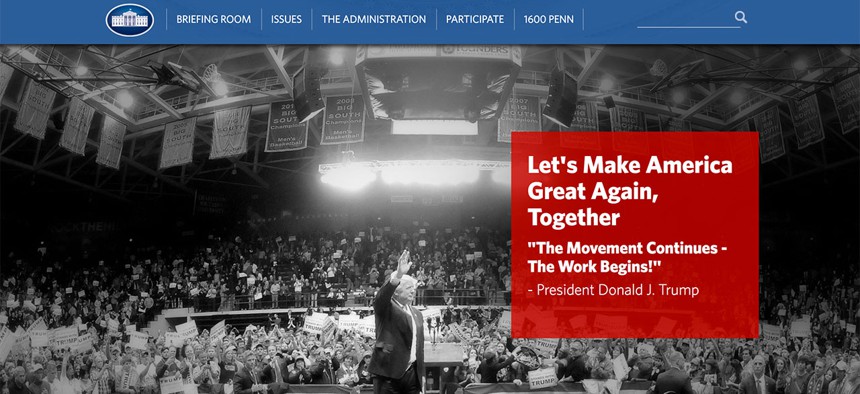
Comparing Trump and Obama's Initial White House Websites
Uploading the whitehouse.gov website really does not take that long.
As is customary, immediately after the transition of power between former US president Barack Obama and new US president Donald Trump, the government’s main executive-branch website, whitehouse.gov, was updated to reflect the new administration.
Given the political distance between the two presidents, it isn’t surprising that the main topics highlighted on the homepage are different now. When Barack Obama was sworn in on Jan. 20, 2009, the site and its homepage were updated at 12:01 pm, and though limited in their content, focused on some of the priorities that were going to define his presidency. There was a post noting the change that had come to the White House, one honoring Martin Luther King Jr., and links to other pages containing the new president’s agenda on economics and energy. The site also contained, up top, a link to Obama’s inauguration speech.

The homepage of whitehouse.gov as of Jan. 20, 2009. (Screen shot via Way Back Machine internet archive)
Donald Trump’s White House homepage took a little longer to be updated, but it, too, reflected the president’s priorities: that is, chiefly, himself.

The home page of whitehouse.gov as of Jan. 20, 2017 (Screen shot via Way Back Machine internet archive)
Besides the prominence given to the speech, there is something else that was quickly noted about the site: Compared with the site of the Obama administration, which in the very first hours had pages dedicated to over 20 key issues in the agenda, Trump’s has a much shorter list of priorities—six in total—and doesn’t appear to direct users to pages for other issues. Amongst the pages that used to exist under the previous administration’s site and have not yet been populated under the new administration five day into Trump’s term are those devoted to policy regarding civil rights, the LGBT community, and climate change. There is also no information related to people with disabilities, the pages dedicated to disclosures are yet to be populated with details, and, perhaps most conspicuously, there is no longer a Spanish-language version or disabled-accessible version of the site, both of which could be found on Obama’s White House site from day one.

Error?
Keyword searches aren’t particularly helpful either. For example, a search for terms such as LGBT or civil rights finds either no results on the site or merely turns up a list of past presidential office-holders connected to the cause.

whitehouse.gov search result for LGBT as of Jan. 24, 2017.

Pages for the missing issues could be restored in due time, or their absence could be the outcome of a policy-related choice not to focus on these issues.
White House press secretary Sean Spicer, asked during a Jan. 23 press conference about the staff’s plans for a Spanish translation, replied that the site is still a work in progress. “As you know, we hit the ground running on day one. We had done a lot of work on the website to make sure that we were prepared to get as much information up as fast as possible. We are continuing to build out the website, both in the issue areas and then that area,” said Spicer, who didn’t share a specific timeline for when the site would be updated. “It’s just going to take a little bit more time, but we’re working piece by piece to get that done,” he said.
In other words, the digital team hasn’t really “hit the ground running,” as Spicer says; quite the opposite. It doesn’t take very long to upload a site, so the delay suggests either a lack of ambition on the part of the White House or a slow rollout of the preparations for the site. That digital communications (Twitter aside) wouldn’t be a priority for the new president shouldn’t surprise, given his personal lack of familiarity with, and mistrust of, computers. But as a consequence, in these early days, the new administration has failed to take full advantage of one of its most prominent public-facing platforms, right in a moment when the internet’s interest in the White House site is at the highest it perhaps has ever been.
Alternatively, it remains possible that the lack of information in Spanish—or about civil rights, the LGBT community, and so on—is actually an accurate reflection of a decision to deliberately ignore those issues, and to adopt an English-only approach.









